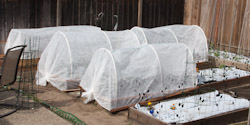Reduce Pests and Diseases By Changing Your Cultural Practices

Often, the best way to deal with pests and diseases in a vegetable garden is by avoiding them altogether. You can do this by changing the timing of your planting of a specific crop so that you avoid a pest altogether or you can select a disease resistant variety of a susceptible vegetable crop. You can also use things like barriers, traps or protective covers to exclude a pest from your crop.
Timing Your Crop to Avoid Insect Pests
The first thing you need to do to use this method is to identify what is eating your plant. This might be obvious as with aphids on leaves or buds or mysterious as when you see holes on the leaves of your plant. You will then need to do some investigating – examine the leaves, check the undersides of the leaves, go out at night with a flashlight etc. Once you identify the culprit, you can go to UC Pest Notes and read about its lifecycle. When does it appear? When is it actively feeding? Once you know that, you can find out if you can grow your crop so that it does not coincide with the insect’s active feeding time.
Selecting Disease Resistant (or Tolerant) Vegetable Varieties
For many years now, plant breeders have sought to produce crops – mostly hybrids - that can resist or tolerate common plant diseases. If you have a problem with a particular disease, you can minimize the damage and maximize your crop by selecting a resistant or tolerant variety. Resistant means that the plant will resist developing the disease while Tolerant means that the plant (if exposed) will develop the disease, but should produce a crop anyway. Resistant is better than Tolerant so look first for Resistant varieties.
| A | Anthracnose |
| AB | Alternaria Early Blight |
| B | Bacterial Wilt |
| F | Fusarium Wilt Race 1 |
| F2 | Fusarium Wilt Race 2 |
| LB | Late Blight |
| N | Nematodes |
| PM | Powdery Mildew |
| R | Common Rust |
| S | Scab |
| TMV | Tobacco Mosaic Virus |
| V | Verticillium Wilt |
| W | Common Wilt |
Barriers, Traps and Protective Covers
If you can’t avoid pests through timing, the next thing to try is exclusion.
- To Identify Pests and Diseases go to UC IPM
- For a more complete discussion of traps and barriers for snails and slugs, see the Snails and slugs pest notes
- Non-Chemical Snail and Slug Control (PDF)
- The Vegetable Research and Information Center

